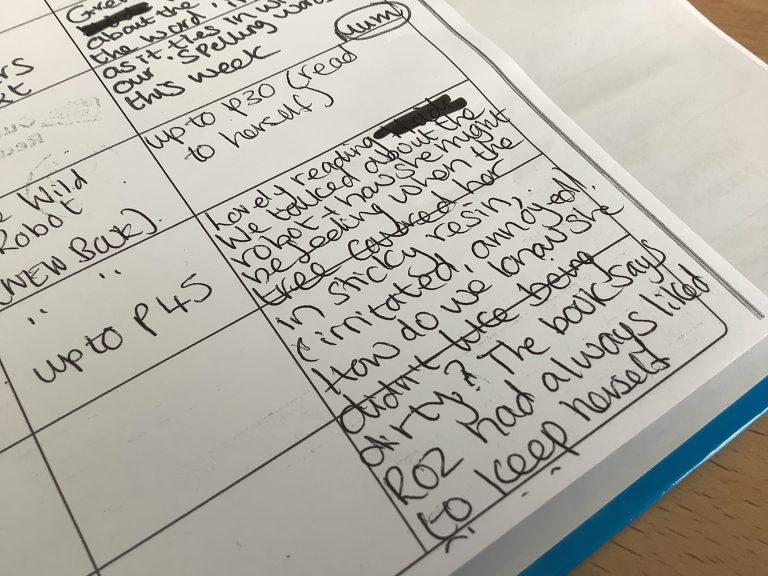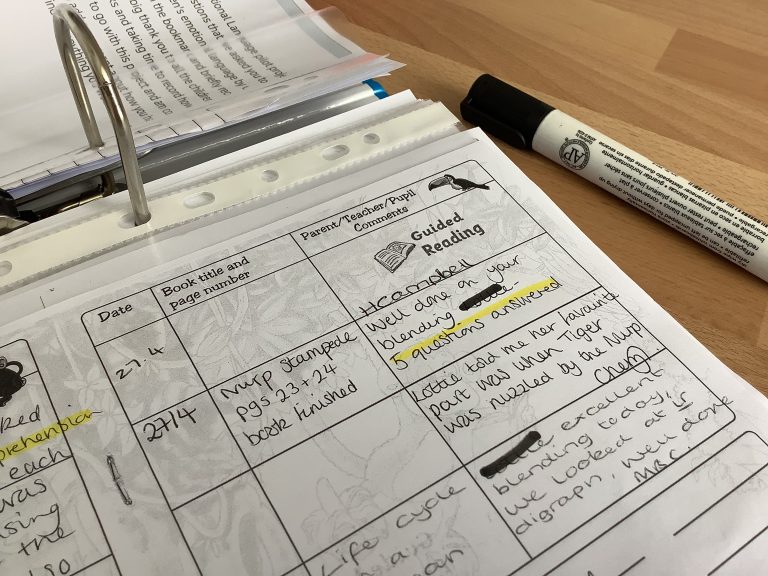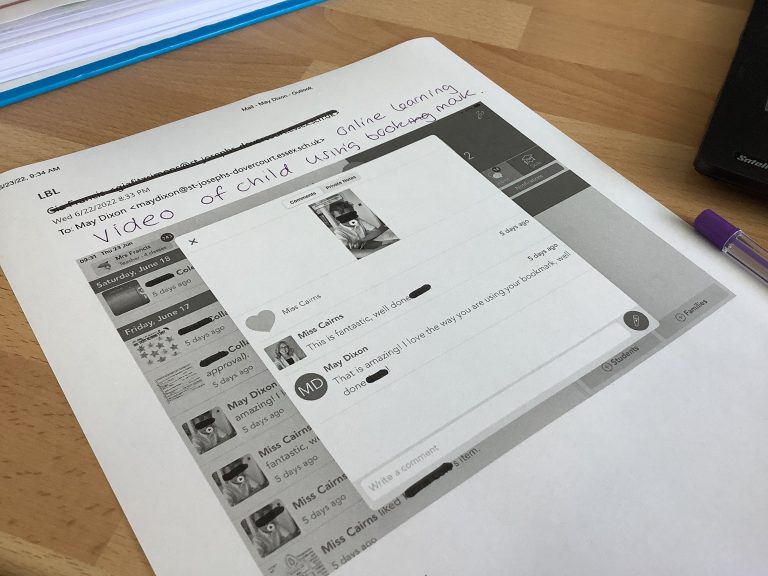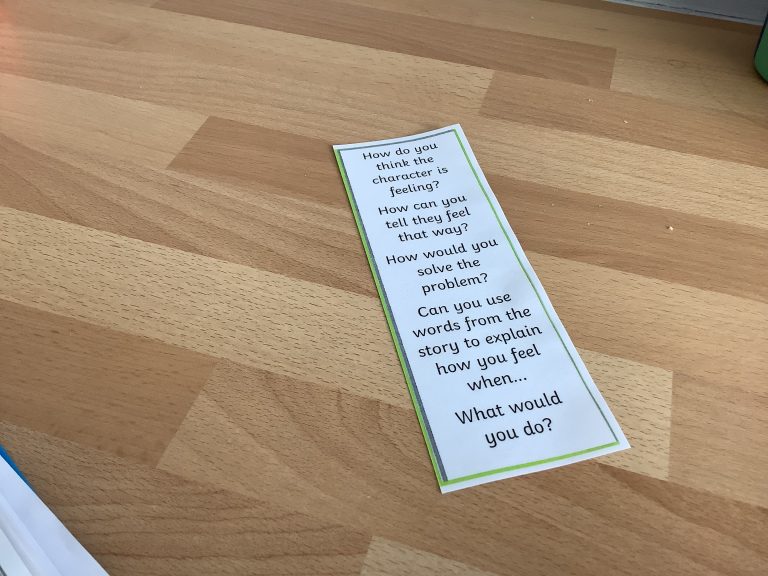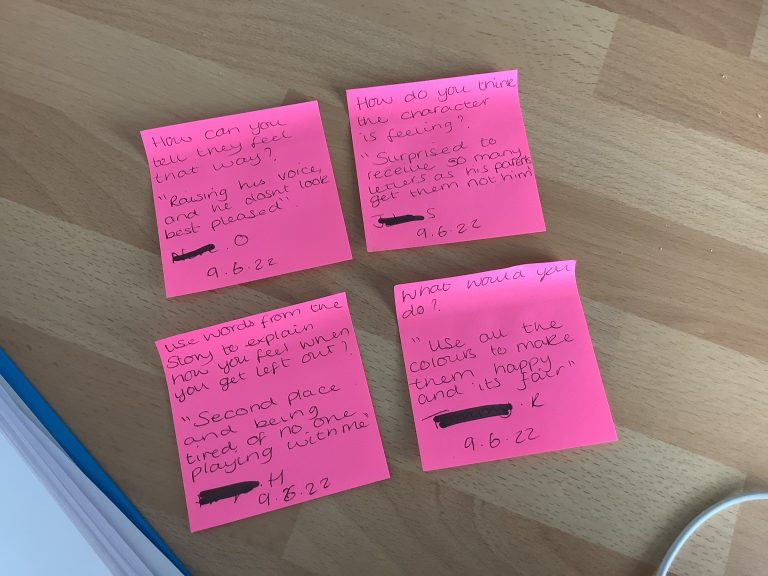The problem I was trying to solve was that some children struggle to identify emotions which can affect their self-regulation. I was hoping to find a way to develop their thinking and expose them to language around emotions. I decided that this required a school/ home approach to gain maximum impact. As children in C2 (UKS1) read daily in school (and frequently at home). I felt that an activity linked to reading would work well. I created a range of questions to use during shared reading and made these into a script on a laminated bookmark for each child to use at home and in school. The class teacher and TA modelled how to use the bookmark when they read aloud to the class. By using a script it gave parents/ carers a base to build on and share responses. Parents/ carers were requested to add brief comments to their child’s reading log. This request was made via our online learning platform as I am aware (through my pastoral role) that this is the preferred communication method for our families. I spoke to our HT and SENCO about the scheme before talking to the class team so that all were in support and understood the aims of the programme. I put together the script (which the SENCO supported) and made the laminated bookmarks. I made spares so that no child needed to go without if original was lost or feel reluctant to ask for replacement. The cost was minimal – resources required were paper, coloured printer ink, laminating sheets and my time to use computer and printer once I had planned the questions.
Our Approach
#931 Identifying Emotions and Managing Self-Regulation – St Joseph’s Catholic Primary
May Dixon
What did we do?
“My mum told me what crestfallen means, it said it in my book, it’s a bit like being really sad.”
A pupil reflecting on what they were learning.
Summary of impact
The bookmarks have worked well because they’re always to hand in the child’s book. They act as a reminder to use them when reading. The teacher has noticed the children talking about problems and what to do for themselves which she believes may have been encouraged by using the resource. I know the scheme is working well as there is evidence in the reading journals in the form of comments written by the adult supporting the child. The children have been exposed to language around feelings by sharing this experience with adults when they read together. They have started to build on alternative words for emotions, extending their vocabulary. Children have developed their own responses at dealing with situations, trying to problem solve as they can reflect upon the examples they have shared in their supported reading.
Steps taken
I initially sought advice from the SENCO and HT about how they felt about my suggestion. They were both able to offer input about where they thought the scheme should be introduced (UKS2) and when (start of Summer term). I looked at children’s reading records and saw that adult comments tended to be non-specific e.g.” lovely reading” and felt that a script at hand would be a useful tool to implement. I felt the project would work well with an all- inclusive approach using collaboration between school and home to gain maximum impact. In school the scheme would be used by any adults that listened to the children read and at home by family members/ carers. As the expectation is that children should read at home daily and have their reading log signed this meant just a small tweak (by using the provided scripted questions). I reviewed the use towards the end of the half term and then used a fresh boost approach after the break by thanking parents for their continued support etc. I created a range of questions and trialled them with the focus age group to ensure they were pitched in such a way that they could be used as they were or used as a starting point to build on. I then made some sample bookmarks which I shared with the SENCO before introducing them to the class team. I met with the class adults to discuss the purpose of the project and received their full support throughout. I sent a message to parents via the online learning platform (their preferred method of contact) and then sent home with the children a laminated bookmark each. The class teacher modelled using hers in class when reading to the children so they were all on board with how to use them. I regularly checked in with the class to see how they were being used and ensured spares were readily available so there was no practical barrier for any child.
A follow up message to parents thanking them for their continued support helped serve as a reminder of the project.
What would we do differently
I kept the bookmarks as straightforward as possible so there was no confusion about use. I think there may be a way to link them to Zones of Regulation by designing questions that relate to the zones and colour coding them accordingly. I would like there to be an incentive to use them (this may be more appropriate with older children or reluctant readers) and I would seek Pupil Voice to see how they feel about this. I would like to extend my bank of questions so they can be swapped half-termly. The challenge was finding a starting point and selecting a pioneer group. With SENCO /HT discussion we decided that C2 (UKS2) would be a good place to launch the scheme as the children read regularly and most have opportunities to have at home support as books go home on a daily basis. The children have at this stage enough reading skills to manage at least one of the suggested questions so no child would be unable to access. Moving forward I can see an opportunity to roll this out for SEN pupils with specific questions to support their individual emotional/social learning needs.
Resources required
Resources required were: paper, printer, printer ink, laminating sheets. My time to create the questions and prepare the resources. Teacher/ TA/ parent/carer time to read with the child and use the resource/ log response. Time to liaise with other staff members about how to use the scheme and check in on effectiveness. The cost of introducing this scheme is therefore minimal.
Further Feedback
The class teacher tells me “It’s raised awareness of their language around feelings. I’ve noticed children studying facial expressions in book illustrations and identifying how the character feels. They’ve started to use their own initiatives to problem solve. Used in conjunction with other class room resources e.g. (Zones of Regulation has just been rolled out school wide) I can see the children recognise a range of emotions in themselves and others.”
The class TA told me she finds the bookmarks very helpful as she’s not just commenting on “lovely reading” or picking up on mis-read words, it’s added another strand to enrich children’s reading experience and develop their emotional language together.
The Headteacher is encouraged by the feedback from Class 2 piloting the scheme and is interested in developing this school wide. She sees an opportunity to link this to Zones of Regulation. It’s something we could introduce from Reception to year 6 and show progress in identifying emotions and using emotional language accordingly.
As a Catholic school we care passionately about supporting our children’s spiritual, moral, cultural and social development. Promoting social and emotional skills through this project is particularly vital for our disadvantaged backgrounds children. We feel social and emotional learning has a positive impact on our learning environment.
The SENCO agrees this scheme will complement Zones of Regulation school wide. She feels that social and emotional learning helps children develop their understanding of their own and other’s emotions, helps them build empathy and make positive relationships and make good choices. This will help support our children’s mental good health and resilience.
Parent: “It’s useful having the suggested questions on the bookmark, we’ve alternated the questions. We have shared some experiences talking about what we would do.”
Contacts
May Dixon
Pastoral Lead
